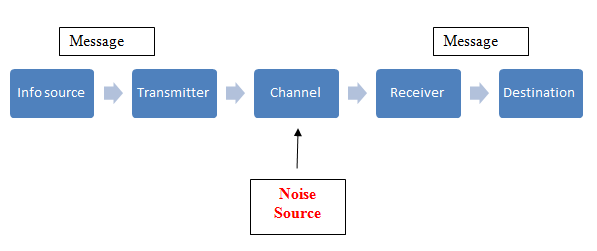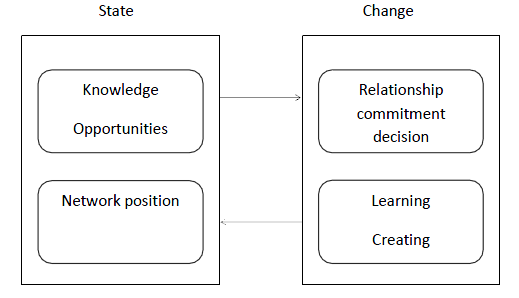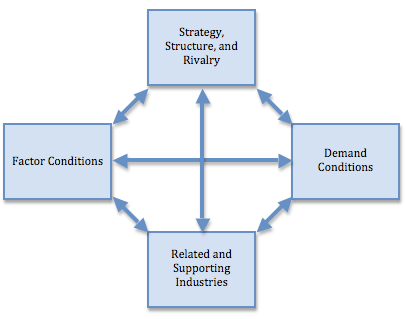Posts by John Dudovskiy

This article proposes a communication model for organisation in health industry. Communication is “a process of circular interaction involving a sender, receiver, and message” (Moran et al., 2007, p. 45) and the quality and level of communication plays an important role in running the operations by the health authority. Facilitation of communication in the health authority organisation in order to send messages to internal and external stakeholder can be explained by application of Shannon and Weaver’s (1949) model of communication which consist of five elements: information source, transmitter, channel, receiver and destination. Shannon and Weaver’s (1949) model of communication Adapted from Chandler (1994) Information source in case of the health authority relates to senior level management aiming to communicate information about changes in the organisation. Transmitter for the health authority relates to press office in case of communication with external stakeholders. In internal communication, on the other hand, line level managers and immediate supervisor may serve as transmitters of messages sent by stop management. Channels available for the health authority to transmit its messages include but not limited to the official website of the organisation, press releases in local and national media, newsletters etc. Receiver can be represented by media for external communications as a wide range of media platforms can discuss official press releases of the health authority organisation thus, causing the message to reach its destination. Destination for communication message represents individuals and parties for whom the message is intended. Noise is an important factor in this model of communication as it can interfere in communication process potentially causing messages to be misunderstood. Therefore, it is important for the health authority management to be proactive in terms of eliminating or at least minimising the noise. References Chandler, D. (1994) “The Transmission Model of Communication” Available at: http://www.aber.ac.uk/media/Documents/short/trans.html…

This brief article discusses information management processes for health authority focusing on information communication technologies. Information is a vital tool for the health authority and its effective management is the most basic responsibility of administrative management. Information management process for the health authority may include the following stages as proposed by Akwetey (2011): 1. Collecting information. In health authority organisation information can be collected from application forms and other internal and external sources. Moreover, primary data collection can be initiated with the use of surveys, focus groups, experiments etc. 2. Processing information. This stage can be greatly assisted by the application of relevant analytical software and the level of sophistication of such software is rapidly increasing. 3. Analysing the information. Information on its own does not represent value in practical levels; therefore information needs to be transformed into knowledge through critical analysis. 4. Acting upon the information. This last stage in information management process is associated with developing recommendations according to analyses of information and application of recommendation in practice. Dramatic development of information technology and intensive integration of internet in increasing range of organisational processes has increased the level of convenience and effectiveness of each stage in information management process. Specifically, information and communication technologies (ICT) represent an effective platform to be used in data collection, processing of information, and data analysis. ICT applications can be divided into two categories: standard and specialised (Shane, 2008). Standard applications can be used in a wide range of industries and purposes and they include word pressing applications such as Microsoft Word and Text Document, database software such as Access, Oracle etc. Specialist ICT applications, on the other hand, are applications that are industry-specific. Specialist applications available for the health authority include Electronic Patient Record Keeping (EPR), Medical Use Expert System (MYCIN) and others. References Akwetey,…

Administration can be defined as “activities involved in managing a business, organisation, or institution” (Macmillan Dictionary, 2014, online). Main differences between administration and management relate to objectives, skills and competencies and the level of involvement in producing products and providing services. Specifically, managers are involved in producing products and providing services in a direct manner, whereas administrators are involved indirectly through developing relevant policies, aims and objectives. Administrative management primarily deals with information needs of managing organisations. Due to the recent restructuring of the health authority and resulting increase of geographical scope of operations encompassing four towns the need for timely and accurate information has increased for senior management. Accordingly, this change has further increased the importance of administrative management for the health authority. Core management functions include planning, organising, staffing, leading and controlling and administration plays an important role in facilitation of these functions in an effective manner. For example, as part of staffing management function health authority senior management need to ensure that employees in new sub-offices in four towns have common set of skills and capabilities for similar positions. This objective can be achieved by application of administrative measures that include formulation of relevant policies and devising effective procedures. Generally, effective administration can benefit the health authority in achieving its organisational objectives in three ways: data processing, office services and systems analysis and design. Data processing can be specified as an important aspect of health authority operations due to increasing relevance and range of data such as patient information, information about suppliers and employees, relative performance of sub-offices etc. Effective administration can assist in data processing practices of the health authority in a range of ways discussed further below in greater details. Office services represent another critical area for the health authority since the organisation has expanded…

According to Horn (2013), although many people have certain opinions about emotional intelligence, the numbers of definitions of the term may be equal to the numbers of authors who addressed this issue. Emotional intelligence has been defined as “the potential to be aware of and use one’s own emotions in communicating with oneself and others and to manage and motivate oneself and others through understanding emotions” (Wharam, 2009, p.11). Alternatively, Bradberry and Greaves (2009) define emotional intelligence as the ability of individuals to understand, express and control their emotions. According to Barrows and Powers (2009) as taken from Oxford English Dictionary hospitality means “the perception and entertainment of guests, visitors or strangers with liberality and good will” (Barrows and Powers, 2009, p.4) Chakraborty and Konar (2009) identify four important attributes of emotions as intensity, brevity, partiality and instability. Intensity relates to the extent of strengths of emotions. Brevity, as an important attribute of emotion relates to its duration. Partiality, on the other hand, is a target such as person or object towards whom or which emotion is directed. Lastly, instability relates to transient psychological and physiological processes experienced by people. According to Bradberry and Greaves (2009) emotional intelligence accounts for 58% of performance for all kinds of jobs. However, Bradberry and Greaves (2009) do not explain methods used to obtain this specific figure and this fact compromises the value and validity of their claim. Moreover, according to Bradberry and Greaves (2009) the levels of personal competence are based on self-awareness and self-management, whereas social competence is based on social awareness and relationship management. Four components of emotional intelligence Source: Bradberry and Greaves (2009) According to Sparrow and Knight (2009) emotions are associated with physiological change such as acceleration of the rate of heartbeat, changes in blood pressure and facial expressions,…

Strategic Theory: Value-Chain Analysis The model of Value-Chain Analysis introduced by Michael Porter (1985) divides business activities into two groups: primary activities and support activities. Primary activities include inbound logistics, operations, outbound logistics, marketing sales, and service and they are related to producing products and services in a direct manner. Support activities, on the other hand, as the name suggests needed to support primary activities of the firm and they consist of firm infrastructure, human resources management, technology development, and procurement. Core benefit of Value-Chain Analysis framework relates to identification and utilisation of opportunities to add more values to certain business processes with positive implications to overall level of competitiveness of the firm. In other words, application of Value-Chain Analysis model provides platform for analysing business processes in an individual manner, so that competitive advantage can be obtained in relation to a specific business process. Moreover, Value-Chain Analysis can be applied to increase the levels of overall strategic competency of the business and strategic competency can be explained as “what in business units does exceptionally well -such as a customer relationship programme, manufacturing, or promotion – that has strategic importance to that business” (Aaker and McLoughlin, 2010, p.7) Inbound logistics relates to a set of activities associated with receiving materials and warehousing and it also includes supply-chain management practices. Operations, on the other hand, relate to the process of transformation of inputs into outputs. Outbound logistics is associated with processing of orders and distribution of products and services. Marketing and sales refers to activities of development and implementation of integrated marketing strategy of the firm. The latest trends in marketing and sales activities can be specified as increasing integration of social media, focus on corporate social responsibility and customer data privacy. Service activities within the framework of Value-Chain Analysis relate to…

This article contains application of Vernon’s Product Life Cycle on the case study of Shanghai Vision Technology Co., Ltd, a medium sized manufacturer of 3D printers and other innovative products based in Shanghai, China. Products of Shanghai Vision Technology to be sold in new markets follow a specific life cycle pattern. This pattern can be effectively explained using Vernon’s product life cycle which comprises four stages: introduction, growth, maturity and decline. Introduction stage for Shanghai Vision Technology 3D printers and other products commences when the product is offered in new market for the first time. During this stage Shanghai Vision Technology products are purchased mainly by ‘innovator’ and ‘early adopter’ consumer categories and the role of effective integrated marketing strategy is paramount. Growth stage for Shanghai Vision Technology products is associated with rapid increase of the sales volume due to the impact of marketing initiatives and word-of mouth marketing. It is important for Shanghai Vision Technology to ensure the supply of its products in the market during this stage. Maturity stage is reached when the majority of Shanghai Vision Technology target customer segment already posses 3D printers and other products offered by the company and its competitors. Maturity stage is associated with market saturation. Decline stage is inevitable for Shanghai Vision Technology products, as well as for products of any other company regardless of the industry and size of the market. Determining the timeframe of this stage in an appropriate manner and introducing new products to the market during the later stages of decline plays an important role for Shanghai Vision Technology in terms of retaining its share in new markets. …

This article contains application of Dunning Eclectic Paradigm on the case study of Shanghai Vision Technology Co., Ltd, a medium sized manufacturer of 3D printers and other innovative products based in Shanghai, China. Exporting can be specified as the most appropriate new market entry strategy for Shanghai Vision Technology during the early stages of internationalisation. Exporting new market entry strategy can be explained a greater depth using Dunning Eclectic Paradigm (DEP) that relies upon three types of advantages – ownership, location and internationalisation advantages. Ownership advantages The choice of exporting as new market entry strategy grants Shanghai Vision Technology the complete ownership advantage of all components of marketing mix. In other words, by choosing exporting the company retains complete freedom in terms of introducing changes to pricing, product specifications, distribution channels and promotion initiatives. Location advantages Ownership and internationalisation advantages to be derived by Shanghai Vision Technology due to the selection of exporting new market entry strategy is going to be facilitated at the expense of location advantages. Specifically, by exporting its products to new markets Shanghai Vision Technology would not possess location advantages with negative implications such as being disadvantaged from tariff barriers and higher transportation costs compared to local businesses. Internationalisation advantages Internationalisation advantages within Dunning Eclectic Paradigm relates to cost advantages that are gained through organising operations within geographical boundaries of new markets. Positive impact of internationalisation to Shanghai Vision Technology is limited during the first stage of international market expansion strategy due to the recommended choice of exporting new market entry strategy. Nevertheless, this specific type of advantage may become available to Shanghai Vision Technology during the later stages of Uppsala model described above once the company establishes sales subsidiaries and production unit abroad.

This article contains application of Uppsala model of internationalisation on the case study of Shanghai Vision Technology Co., Ltd, a medium sized manufacturer of 3D printers and other innovative products based in Shanghai, China. Uppsala model of internationalisation also known as a learning theory of internationalisation identifies four individual steps of internationalisation. According to Uppsala model engaging in exporting in occasional manner should constitute the first step in internationalisation. Initial experience of operating in the new market is going to be gained by Shanghai Vision Technology during this step. Exporting through sales agents in new markets marks the second step in internationalisation. Presence of the company in the new market is going to be increased during this step with positive implications on the levels of knowledge about unique aspects of the market. Establishment of Shanghai Vision Technology sales subsidiaries in foreign market is the third step of internationalisation according to the model. During this step the company is in the position of obtaining experience and knowledge about the market in a direct manner. Starting the production in the foreign market through wholly owned subsidiaries is the last step of internationalisation within the framework of Uppsala model of internationalisation. This step is associated with benefiting from ownership, location and internationalisation advantages by Shanghai Vision Technology to a full extent which is explained with the application of Dunning Electric Paradigm further below. Importantly, Uppsala model acknowledges the lack of knowledge about specifications of new markets to be an important barrier in terms of becoming successful in respective market. In other words, unlike many other models of internationalisation, Uppsala model rightly specifies knowledge about the market as a critical success factors. Revised version of Uppsala model contains the application of basic networking prospect in a way that mutual interactions and influence of state…

This article contains application of Diamond of National Advantage on the case study of Shanghai Vision Technology Co., Ltd, a medium sized manufacturer of 3D printers and other innovative products based in Shanghai, China. Main motive for internationalisation for Shanghai Vision Technology relates to attempts to increase the levels of revenues through international market expansion strategy. The idea of Competitive Advantage of Nations proposed by Porter (1990) is based on four major points of competitive advantage jointly referred to as the Diamond of National Advantage that can be applied to the case study of Shanghai Vision Technology in the following manner: Factor conditions within the framework of the Diamond of National Advantage are favourable towards Shanghai Vision Technology internationalisation perspectives. This is because adequate infrastructure has been developed in China mainly during the last two decades in industry of advanced technologies such as 3D printing to serve as a platform for local manufacturers to compete globally. Demand conditions can also be specified as an important factor that contributes to the level of global competitiveness of Shanghai Vision Technology. In other words, there are not major differences in the nature of demand for 3D printers in home market in China and foreign markets. Therefore, Shanghai Vision Technology’s present successful operation in home market in China can be rightly perceived as a prerequisite for success in the global marketplace to a certain extent. Related and supporting industries in relation to advanced technologies such as 3D printer manufacturing are effectively established in China. Moreover, China is a manufacturing home for a wide range of components of advanced technological products and cost advantage of those components can be specified as an additional point of strengths for Shanghai Vision Technology to compete in a global market. Firm strategy, structure and rivalry is another important point…
By John Dudovskiy
Category: International Business

Employee motivation tools can be divided into two categories: tangible and intangible. Salary and monetary bonuses is the main form of tangible motivation tools, whereas intangible motivation tools include sense of contributing to a great cause, recognition of employee performance by managers in verbal and written ways, celebrations of group and individual achievements etc. Both, tangible and intangible tools of motivation are going to be used in relations with chefs and sales assistant before and during the International Food Event. Tangible motivational tools offered to staff include financial compensation of £8 per hour. A set of intangible motivational tools to be used in this event include verbal encouragement of staff at all stages of the event, explanation of contribution of the event in terms of increasing the levels of cross-cultural awareness, and contributing to good cause as the profit to be made from the sale of food and ingredients are to be donated to the selected charity. Moreover, application of Hertzberg’s Two-Factor Theory (1959) assists in explaining staff and volunteer motivation practices in International Food Event. Two-Factor Theory makes a clear distinction between hygiene factors and motivators. Hygiene factors include salaries, adequate working conditions, appropriate management-employee relationships, acceptable levels of work-life balance etc. Hygiene factors are expected by employees to be in place and their presence may prevent dissatisfaction amongst employees. However, the presence of hygiene factors is not sufficient for employee motivation and employee motivation can only be achieved through the application of motivator factors. Accordingly, motivator factors to be applied in International Food Event include creating challenging, yet rewarding working environment, recognition of contribution of chefs, encouraging the sense of personal achievement due to the participation in the event etc. Alternatively, the issues of motivation at the event can be explained using the framework of Theory X and…
